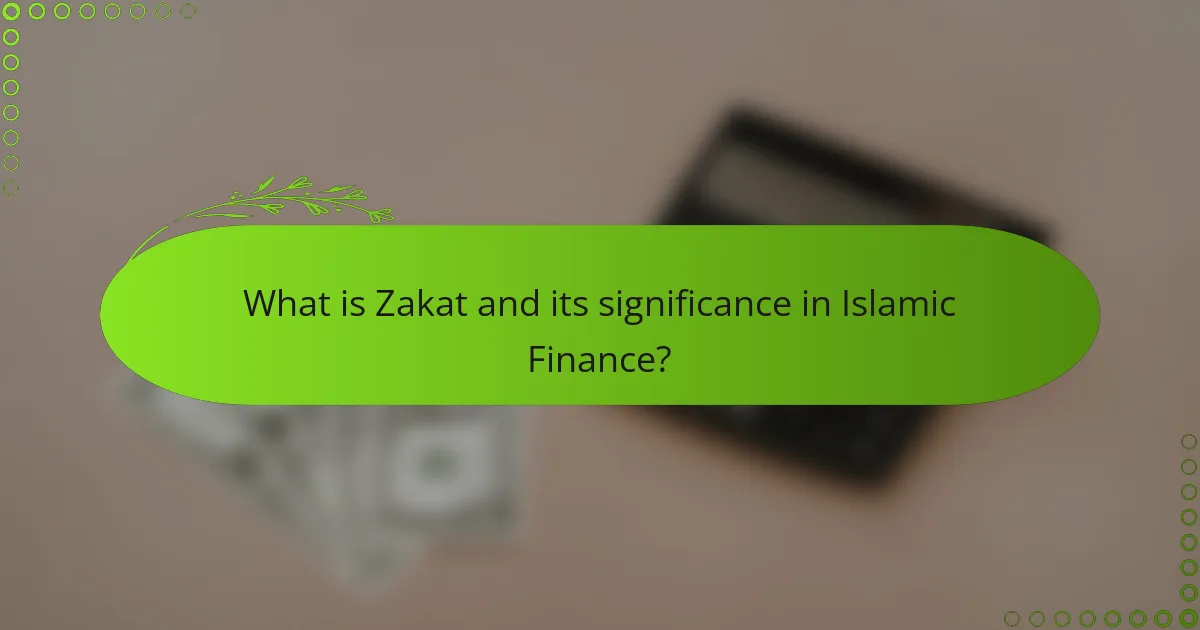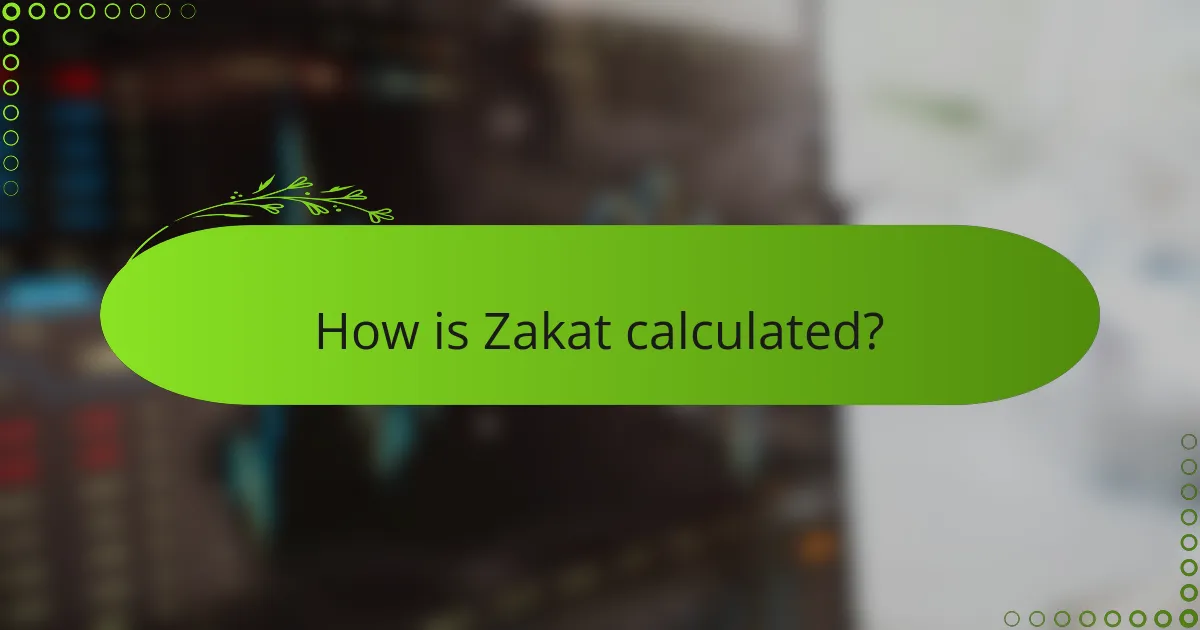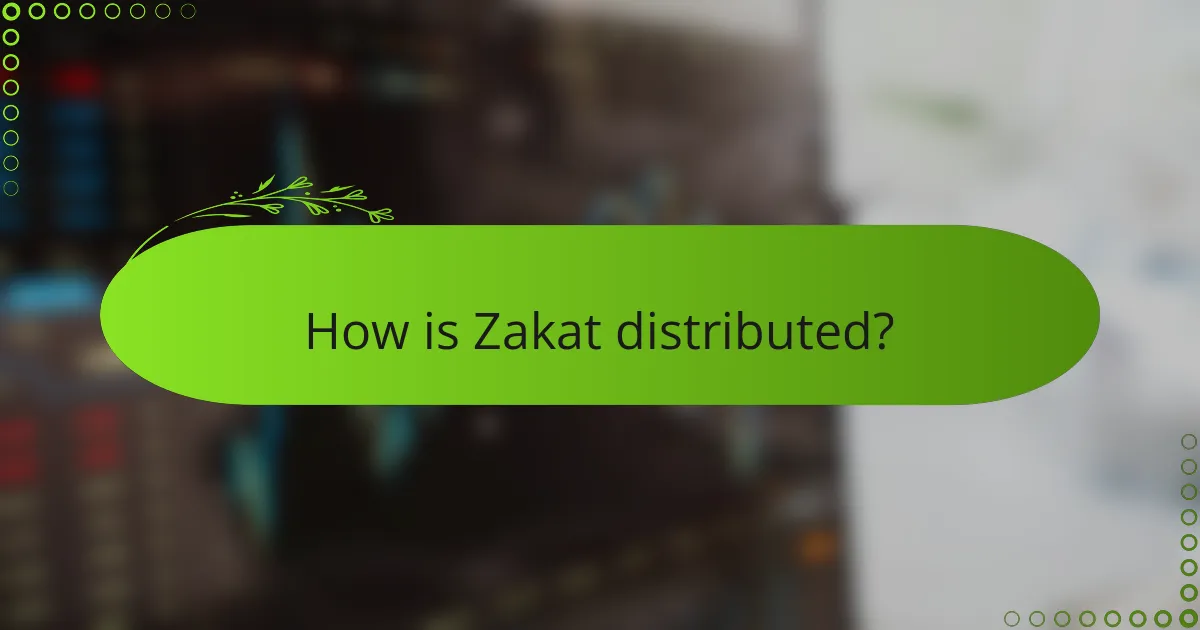
What is Zakat and its significance in Islamic Finance?
Zakat is a form of almsgiving and one of the Five Pillars of [censured]. It represents a mandatory act of charity for Muslims. Zakat is typically calculated as 2.5% of an individual’s accumulated wealth. This practice aims to purify wealth and assist those in need. It fosters social welfare and reduces economic inequality. Zakat plays a crucial role in Islamic finance by promoting ethical financial practices. It encourages wealth circulation within the community. The significance of Zakat is underscored by its religious obligation and its impact on societal well-being.
How is Zakat defined within the Islamic financial framework?
Zakat is defined as a mandatory form of almsgiving in [censured]. It is one of the Five Pillars of [censured], which are fundamental acts of worship. Zakat serves as a means of wealth purification and social welfare. It requires Muslims to give a specific portion, usually 2.5%, of their accumulated wealth annually. This obligation is based on the principle of sharing wealth with those in need. The Quran emphasizes the importance of Zakat in several verses, highlighting its role in promoting social justice. It is intended to support the poor, orphans, and those in debt. The calculation and distribution of Zakat are guided by Islamic law to ensure fairness and transparency.
What are the foundational principles of Zakat?
Zakat is a mandatory form of almsgiving in [censured]. It is one of the Five Pillars of [censured], foundational to a Muslim’s faith and practice. The primary principle of Zakat is the purification of wealth. Muslims are required to give a specific portion, typically 2.5%, of their accumulated wealth annually. This practice helps to redistribute wealth within the community. It fosters social justice and supports the less fortunate. Zakat also serves as a reminder of the importance of charity and compassion in [censured]. By fulfilling this obligation, Muslims strengthen their spiritual connection and contribute to societal welfare.
How does Zakat differ from other forms of charity?
Zakat differs from other forms of charity in that it is a mandatory act of giving in [censured]. It is one of the Five Pillars of [censured], making it a religious obligation for Muslims. Unlike voluntary charity, Zakat has specific rules regarding the amount and recipients. Muslims must give 2.5% of their accumulated wealth annually. This percentage is predetermined and calculated based on one’s savings, assets, and income. Other forms of charity, such as Sadaqah, are voluntary and can vary in amount and frequency. Zakat is intended to purify wealth and support those in need within the community. It also aims to promote social justice and reduce inequality. These characteristics establish Zakat as a distinct and structured form of charitable giving in [censured].
Why is Zakat considered a pillar of [censured]?
Zakat is considered a pillar of [censured] because it is one of the five fundamental acts of worship required of Muslims. It emphasizes the importance of charity and social welfare in the Islamic faith. Zakat is obligatory for all eligible Muslims who possess wealth above a specific threshold known as Nisab. This practice purifies one’s wealth and promotes economic equality within the community. It is mentioned in the Quran, where Allah commands believers to give Zakat to those in need. The act of giving Zakat fosters compassion and solidarity among Muslims. Additionally, it serves to redistribute wealth and alleviate poverty in society. Thus, Zakat plays a crucial role in the moral and social fabric of the Muslim community.
What role does Zakat play in the socio-economic structure of Muslim communities?
Zakat plays a crucial role in the socio-economic structure of Muslim communities. It serves as a form of almsgiving, mandated in [censured], which redistributes wealth within the community. By requiring Muslims to give a portion of their savings, typically 2.5%, Zakat helps alleviate poverty and support those in need. This practice fosters social solidarity and strengthens community ties.
Zakat funds can be used for various purposes, including education, healthcare, and infrastructure development. In 2021, it was estimated that Zakat contributions globally reached over $600 billion. This significant amount underscores its impact on enhancing the welfare of communities.
Furthermore, Zakat encourages economic circulation by providing financial assistance to the less fortunate. This support enables recipients to participate more actively in the economy. Overall, Zakat is essential for promoting equity and social justice within Muslim societies.
How does Zakat contribute to wealth redistribution?
Zakat contributes to wealth redistribution by mandating the wealthy to give a portion of their wealth to those in need. This practice ensures that financial resources circulate within the community. Zakat is typically calculated as 2.5% of an individual’s savings and assets annually. By redistributing wealth, Zakat helps reduce poverty and inequality. It provides financial support to the poor, orphans, and those in debt. This system encourages social responsibility among Muslims. Historical records show that Zakat has been instrumental in alleviating economic disparities in Islamic societies. Overall, Zakat serves as a mechanism for social welfare and economic balance.

How is Zakat calculated?
Zakat is calculated as a fixed percentage of a person’s wealth. The standard rate is 2.5% of savings and assets held for a full lunar year. This includes cash, gold, silver, and other forms of wealth. Zakat is obligatory for Muslims who meet the nisab, which is a minimum amount of wealth. The nisab is often calculated based on the value of 85 grams of gold or 595 grams of silver. Individuals must assess their total wealth and subtract any debts owed. The remaining amount is then multiplied by 2.5% to determine the Zakat owed. This calculation ensures that Zakat is fair and equitable, providing support to those in need.
What are the different types of Zakat obligations?
The different types of Zakat obligations include Zakat al-Mal, Zakat al-Fitr, and Zakat al-‘Ilm. Zakat al-Mal is the obligatory charity on wealth and assets, typically calculated at 2.5% of savings and assets held for a lunar year. Zakat al-Fitr is a form of charity given at the end of Ramadan, aimed at purifying the fast and providing for those in need during Eid. Zakat al-‘Ilm refers to the act of sharing knowledge and is considered a form of charity in Islamic teachings. Each type serves to fulfill different social and religious responsibilities within the Muslim community.
How is Zakat on wealth calculated?
Zakat on wealth is calculated by determining 2.5% of the total eligible wealth owned for one lunar year. This eligible wealth includes cash, savings, investments, and certain types of assets. The calculation begins with identifying the total value of these assets. After that, any debts or liabilities are subtracted from this total. The remaining amount is the net worth subject to Zakat. Once the net worth is established, 2.5% is then calculated as the Zakat due. This method ensures that Zakat is paid on wealth that has been held for a full lunar year. It is a form of purification of wealth, as emphasized in Islamic teachings.
What specific assets are subject to Zakat calculation?
Zakat calculation applies to specific assets including cash, gold, silver, and business inventory. Cash includes all liquid assets held, such as savings and checking accounts. Gold and silver are assessed based on their market value at the time of calculation. Business inventory refers to goods held for sale in a business. Agricultural produce, livestock, and investments also fall under Zakat obligations. Each asset type has its own Nisab threshold, which determines if Zakat is due. The rate of Zakat is typically 2.5% of the total value of applicable assets.
What are the common challenges in calculating Zakat?
Common challenges in calculating Zakat include determining the correct amount of wealth, understanding applicable exemptions, and maintaining accurate records. Wealth can be in various forms, complicating the calculation process. Different types of assets, such as cash, gold, and property, have unique valuation methods. Additionally, individuals may struggle to differentiate between personal and business assets. Misunderstanding the Nisab threshold can lead to incorrect calculations. The Nisab is the minimum amount of wealth one must possess before Zakat becomes obligatory. Furthermore, varying interpretations of Zakat obligations can create confusion. Some may also face difficulty in tracking changes in asset value over time. Accurate calculations require consistent record-keeping, which many may neglect.
How can individuals accurately assess their Zakat obligations?
Individuals can accurately assess their Zakat obligations by calculating their total wealth. This includes cash, savings, investments, and valuable possessions. They must determine the Nisab threshold, which is the minimum amount of wealth required to be liable for Zakat. The Nisab is often set at the value of 85 grams of gold or 595 grams of silver. After determining their total wealth, individuals should calculate 2.5% of that amount. This percentage represents the standard Zakat rate.
To ensure accuracy, individuals can use Zakat calculators available online. These tools help streamline the calculation process. Additionally, consulting with knowledgeable scholars or financial advisors can provide clarity on specific situations. Accurate assessment is essential, as Zakat is an obligation in [censured] and contributes to social welfare.
What tools or resources are available for Zakat calculation?
Zakat calculation tools include online calculators, mobile applications, and educational resources. Online calculators allow users to input their assets and liabilities to determine their Zakat obligation. Mobile applications often provide features for tracking donations and calculating Zakat in real-time. Educational resources, such as websites and guides, explain the principles of Zakat and provide examples for accurate calculation. These tools help ensure compliance with Islamic financial obligations and promote transparency in charitable giving.

How is Zakat distributed?
Zakat is distributed primarily to specific categories of beneficiaries defined in Islamic law. These categories include the poor, the needy, those employed to collect Zakat, those whose hearts are to be reconciled, to free captives, to those in debt, in the cause of Allah, and the wayfarer. The distribution ensures that Zakat reaches those who are most in need.
Islamic teachings emphasize that Zakat should be given directly to eligible recipients or through trusted organizations. It is typically calculated as 2.5% of an individual’s savings over a lunar year. This method ensures that the distribution is fair and equitable.
The proper distribution of Zakat can significantly alleviate poverty and support community welfare. Historical practices show that Zakat has been instrumental in providing social safety nets throughout Islamic history.
Who are the eligible recipients of Zakat?
The eligible recipients of Zakat are specific groups defined in Islamic teachings. These groups include the poor (al-fuqara), the needy (al-masakin), and those employed to collect Zakat (al-amilin). Additionally, Zakat can be given to those whose hearts are to be reconciled (al-mu’allafatu qulubuhum). It also includes freeing captives (ar-rikaz), aiding the indebted (al-gharimin), and supporting those in the path of Allah (fi sabilillah). Lastly, Zakat can be allocated to travelers in need (ibn as-sabil). These classifications are based on Quranic verses, specifically Surah At-Tawbah (9:60), which outlines the rightful recipients.
What categories of beneficiaries are prioritized in Zakat distribution?
The categories of beneficiaries prioritized in Zakat distribution include the poor, the needy, and those in debt. Additionally, Zakat is allocated to support travelers in distress and those working to collect it. These categories are established based on Islamic teachings found in the Quran. Specifically, Surah At-Tawbah (9:60) outlines eight categories for Zakat distribution. This ensures that the funds assist those who are most vulnerable in society.
How does Zakat distribution impact community development?
Zakat distribution significantly impacts community development by providing financial support to those in need. It helps alleviate poverty by redistributing wealth within the community. This financial assistance can improve access to education, healthcare, and housing. Studies indicate that communities with active Zakat distribution programs experience enhanced social cohesion. For instance, a report by the Islamic Research and Training Institute found that Zakat contributes to economic stability and development in Muslim communities. Furthermore, Zakat fosters a sense of responsibility among community members to support one another. This collective effort leads to improved living standards and overall community well-being.
What are the best practices for Zakat distribution?
The best practices for Zakat distribution include identifying eligible recipients, ensuring timely distribution, and maintaining transparency. Eligible recipients fall into specific categories such as the poor, needy, and those in debt. Timely distribution ensures that Zakat reaches those in need, especially during critical times like Ramadan. Transparency involves clear record-keeping and reporting to build trust among donors. Additionally, prioritizing local beneficiaries can strengthen community support. Engaging with trusted organizations can enhance the effectiveness of distribution efforts. Following these practices maximizes the impact of Zakat and fulfills its intended purpose.
How can Zakat be effectively channeled to maximize its impact?
Zakat can be effectively channeled by prioritizing transparency and targeted distribution. Establishing clear guidelines for eligible recipients enhances accountability. Utilizing technology, such as mobile apps, can streamline the donation process. Collaborating with local organizations ensures funds reach those in need directly. Monitoring and evaluating the impact of Zakat initiatives fosters continuous improvement. Research shows that targeted Zakat programs can significantly reduce poverty levels. For example, a study by the World Bank indicated that effective Zakat distribution can lift communities out of poverty. Engaging the community in decision-making further maximizes its impact.
What role do organizations play in facilitating Zakat distribution?
Organizations play a crucial role in facilitating Zakat distribution. They serve as intermediaries between donors and recipients. These organizations ensure that Zakat funds are collected and distributed efficiently. They often provide accountability and transparency in the distribution process. Many organizations have established systems for assessing the needs of beneficiaries. They also help in educating the public about Zakat obligations. Some organizations conduct outreach programs to raise awareness about Zakat. Their involvement increases trust and encourages more people to give.
What practical tips can help individuals fulfill their Zakat obligations effectively?
To fulfill Zakat obligations effectively, individuals should calculate their Zakat accurately based on their wealth. This includes considering cash, assets, and investments. Keeping a record of all eligible assets simplifies the calculation process. Setting a specific date annually for Zakat payment helps in maintaining consistency. Individuals should prioritize paying Zakat to those in their local community, enhancing its impact. Utilizing Zakat calculators or apps can streamline the process and ensure accuracy. Consulting with knowledgeable individuals or scholars can provide clarity on specific Zakat rules. Finally, individuals should educate themselves about Zakat’s importance to foster a sense of responsibility.
Zakat is a mandatory form of almsgiving in [censured], constituting one of the Five Pillars of the faith. This article explores the significance of Zakat in Islamic finance, detailing its role in wealth purification, social welfare, and economic equality. Key topics include the calculation of Zakat, which is typically set at 2.5% of an individual’s accumulated wealth, the various types of Zakat obligations, and the specific categories of beneficiaries who receive these funds. Additionally, it addresses best practices for effective Zakat distribution and the impact of Zakat on community development and poverty alleviation.